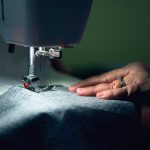History of Garments Industry in Bangladesh

Like other 3rd world countries Bangladesh is a developing country. Her economic development depends firstly on agriculture and secondly on industry. Although Bangladesh is not developed in industry, it has been enriched in Garment industries in the recent past years. In the field of Industrialization garment industry is a promising step. It has given the opportunity of employment to millions of unemployed, especially innumerable uneducated women of the country. It is making significant contribution in the field of our export income.
Historical background of the Garment Industry:
Once the cloth of Bangladesh achieved worldwide fame specially muslim and jamdani cloth or our country was used as the luxurious garments of the royal figures in Europe and other countries. The British rulers in India didn’t develop our cloth industries at all. Rather they destroyed them and imported cloths from England. Garment Industry Large-scale production of readymade garments (RMG) in organized factories is a relatively new phenomenon in Bangladesh. Until early sixties, individual tailors made garments as per specifications provided by individual customers who supplied the fabrics. The domestic market for readymade garment, excepting children wears and men’s knit underwear (genji) was virtually non-existent in Bangladesh until the sixties.
Since the late 1970s, the RMG industry started developing in Bangladesh primarily as an export-oriented industry although; the domestic market for RMG has been increasing fast due to increase in personal disposable income and change in life style. The sector rapidly attained high importance in terms of employment, foreign exchange earnings and its contribution to GDP.
Most importantly, the growth of RMG sector produced a group of entrepreneurs who have created a strong private sector. Of these entrepreneurs, a sizeable number is female. A woman entrepreneur established one of the oldest export-oriented garment factories, the Baishakhi Garment in 1977. Many women hold top executive positions in RMG industry.The hundred percent export-oriented RMG industry experienced phenomenal growth during the last 15 or so years. In 1978, there were only 9 export-oriented garment manufacturing units, which generated export earnings of hardly one million dollar. Some of these units were very small and produced garments for both domestic and export markets. Four such small and old units were Reaz Garments, Paris Garments, Jewel Garments and Baishakhi Garments.
Reaz Garments, the pioneer, was established in 1960 as a small tailoring outfit, named Reaz Store in DHAKA. It served only domestic markets for about 15 years. In 1973 it changed its name to M/s Reaz Garments Ltd. and expanded its operations into export market by selling 10,000 pieces of men’s shirts worth French Franc 13 million to a Paris-based firm in 1978. It was the first direct exporter of garments from Bangladesh. Desh Garments Ltd, the first non-equity joint-venture in the garment industry was established in 1979. Desh had technical and marketing collaboration with Daewoo Corporation of South Korea. It was also the first hundred percent export-oriented company. It had about 120 operators including 3 women trained in South Korea, and with these trained workers it started its production in early 1980. Another South Korean Firm, Youngones Corporation formed the first equity joint-venture garment factory with a Bangladeshi firm, Trexim Ltd. in 1980. Bangladeshi partners contributed 51% of the equity of the new firm, named Youngones Bangladesh. It exported its first consignment of padded and non-padded jackets to Sweden in December 1980.
Till the end of 1982, there were only 47 garment manufacturing units. The breakthrough occurred in 1984-85, when the number of garment factories increased to 587. The number of RMG factories shot up to around 2,900 in 1999. Bangladesh is now one of the 12 largest apparel exporters of the world, the sixth largest supplier in the US market and the fifth largest supplier of T-shirts in the EU market. The industry has grown during the 1990s roughly at the rate of 22%.
The growth of the industry in terms of number of units and employment generation is shown in table – 1 below:
|
Year |
Number of Garment Industries |
Employment in Million Workers |
|
1983-84 |
134 |
0.040 |
|
1988-89 |
759 |
0.317 |
|
1993-94 |
1839 |
0.827 |
|
1998-99 |
2963 |
1.500 |
|
2003-04 |
3957 |
2.000 |
|
2008-09 |
4825 |
3.100 |
[Source: BGMEA]
At present there are about 5000 garment industries in the country and 75 percent of them are in Dhaka. The rest are in Chittagong and Khulna. These Industries have employed fifty lacks of people and 85 percent of them are illiterate rural women. About 76 percent of our export earning comes from this sector.
The country’s RMG sector, to a creditable level has relieved Bangladesh from over populous unemployment burden through providing the largest employment next to agriculture, transport, and trade and industry sector. This sector has uplifted the neglected section of the population, thus radically transforming the socio-economic condition of the country. Such empowerment and employment raised awareness regarding children education, health safety, population control disaster management only so for. It is an epoch making event in the history of Bangladesh.
Motahar Hossain Rana



